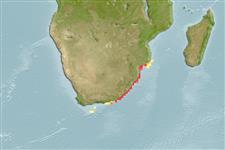>
Clupeiformes (Herrings) >
Engraulidae (Anchovies) > Engraulinae
Etymology: Stolephorus: Greek, stole, -es = garment + Greek, pherein = to carry (Ref. 45335).
More on author: Boulenger.
Environment: milieu / climate zone / depth range / distribution range
Ecología
marino; salobre; oceanodromo (Ref. 51243); rango de profundidad 0 - 50 m (Ref. 189). Subtropical; 24°S - 40°S, 21°E - 37°E (Ref. 189)
Indian Ocean: Southwestern Indian Ocean, from northern Mozambique south to Port Elizabeth in South Africa (Ref. 189, 5430), including estuaries of Zwartkops River (Ref. 189, 5430), Kei River (Ref. 189) and Umtata River (Ref. 81587).
Tamaño / Peso / Age
Maturity: Lm ? range ? - ? cm
Max length : 8.0 cm SL macho / no sexado; (Ref. 189)
Espinas dorsales (total): 0; Radios blandos dorsales (total): 15-17; Espinas anales 0; Radios blandos anales: 20 - 23. Diagnosis: Body somewhat compressed, belly with 6-8 small needle-like pre-pelvic scutes, no post-pelvic scutes; maxilla tip pointed, reaching to or beyond hind border of pre-operculum, the latter concave, indented near maxilla tip; lower gillrakers 24-29; anal fin short, usually with 3 unbranched and 17-20 branched finrays, its origin below about middle of dorsal fin base (Ref. 189, 5430). Of similar species in its distribution area, Stolephorus indicus is round-bodied and has a shorter maxilla, not to hind border of pre-operculum; and Encrasicholina punctifer has the anal fin origin behind the dorsal fin base (Ref. 189).
A coastal, pelagic and schooling species; its presence in estuaries suggests that it can tolerate brackish water (Ref. 189). It is common along shore and in estuaries (Ref. 5430). It feeds on plankton, mainly copepods (Ref. 58304). It spawns in summer, usually at sea (Ref. 58304).
Life cycle and mating behavior
Madurez | Reproducción | Puesta | Huevos | Fecundidad | Larva
Whitehead, P.J.P., G.J. Nelson and T. Wongratana, 1988. FAO Species Catalogue. Vol. 7. Clupeoid fishes of the world (Suborder Clupeoidei). An annotated and illustrated catalogue of the herrings, sardines, pilchards, sprats, shads, anchovies and wolf-herrings. FAO Fish. Synop. 125(7/2):305-579. Rome: FAO. (Ref. 189)
IUCN Red List Status (Ref. 130435)
Threat to humans
Harmless
Human uses
Más información
Nombres comunesSinónimosMetabolismoDespredadoresEcotoxicologíaReproducciónMadurezPuestaAgregación para la puestaFecundidadHuevosEgg development
ReferenciasAcuiculturaPerfil de acuiculturaRazasGenéticaElectrophoresesheritabilidadEnfermedadesProcesamientoNutrientsMass conversion
ColaboradoresImágenesStamps, Coins Misc.SonidosCiguateraVelocidadTipo de nataciónSuperficie branquialOtolitosCerebrosVisión
Herramientas
Special reports
Download XML
Fuentes de Internet
Estimates based on models
Preferred temperature (Ref.
123201): 21.2 - 24.9, mean 24.3 °C (based on 12 cells).
Phylogenetic diversity index (Ref.
82804): PD
50 = 0.5000 [Uniqueness, from 0.5 = low to 2.0 = high].
Bayesian length-weight: a=0.00759 (0.00432 - 0.01334), b=3.19 (3.04 - 3.34), in cm total length, based on LWR estimates for this species & (Sub)family-body (Ref.
93245).
Nivel trófico (Ref.
69278): 3.3 ±0.4 se; based on size and trophs of closest relatives
Resiliencia (Ref.
120179): Alto, población duplicada en un tiempo mínimo inferior a 15 meses (Preliminary K or Fecundity.).
Fishing Vulnerability (Ref.
59153): Low vulnerability (10 of 100).
